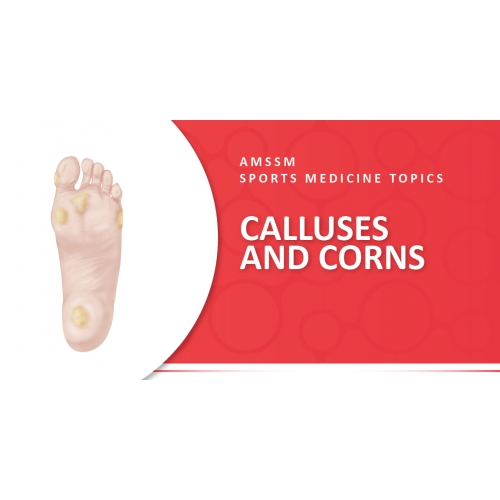 Background Calluses and corns are benign lesions of the skin that are most prominently found on the feet or hands but can present on any skin surface. They may be painless or may be associated with pain or discomfort, particularly when they are on weight-bearing surfaces (the bottom of feet) or areas of high-use (fingers or the palms of hands). • Calluses are thickening of the outermost layer of the skin in response to repeated pressure or friction. They are usually yellowish or gray in color, are firm to the touch and are usually not painful. • Corns are similar to calluses; however, they generally have a central “core” of skin that may have a different color or texture. The core may be hard or soft depending on the location of the corn (i.e. if the corn is in an area associated with sweat or moisture, the corn may have a soft core). Corns are more likely to be painful than are calluses. Symptoms/Risks The most common risk associated with the development of calluses and corns includes the use of poorly-fitting athletic equipment including footwear that is too tight or too loose. Abnormalities such as hammer toes or bunions predispose patients to developing lesions, as they are surfaces of increased friction and pressure. You may develop a callus or corn from wearing shoes without socks or walking around barefoot. Repeated handling of an object that puts pressure on the hands, such as tools (rakes or hammers) or sports equipment (tennis racquets or baseball bats), increases the risk of developing calluses on the hands. Sports Medicine Evaluation and Treatment If you visit your sports medicine physician, they will perform a complete history, evaluating your hobbies and activities to identify possible risks or modifiable activities. They will also perform a physical exam, as calluses and corns are usually diagnosed by their appearance alone. In general, they will not need to perform any imaging, however they may recommend and X-ray if they are concerned that a bone problem may be contributing to your symptoms. Treatment of these lesions may include using a small pad or cushion to cover the callus or corn and prevent friction or pressure, which will usually result in the callus or corn healing on its own. If the lesion does not heal on its own, your doctor may use a small blade to scrape off some of the abnormal skin or use a medicine (called salicylic acid) which will soften the skin so that they may scrape more of the lesion off. This process may be repeated numerous times until the trouble spot is gone. Injury Prevention The best way to prevent calluses and corns is to check that you have properly fitting footwear, avoid frequently walking barefoot or wearing shoes without socks, avoid repetitive activities or motions that cause friction or frequent rubbing of the same area(s) of skin and use protective equipment such as gloves when using tools that repetitively rub the skin. Return to Play While it may cause discomfort to perform specific activities or play sports with calluses and corns, there is no reason to avoid returning to play. Pain may be improved with proper equipment and padding to allow you to return to play with comfort. AMSSM Member Authors References Category: Dermatology (Skin) Issues, Foot and Ankle, Hand and Wrist, [Back] |

